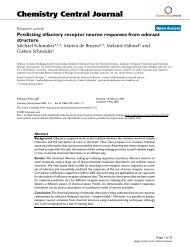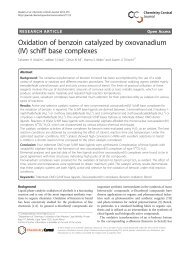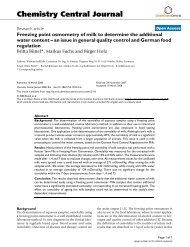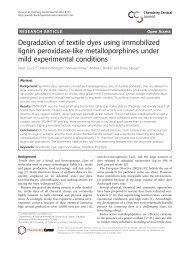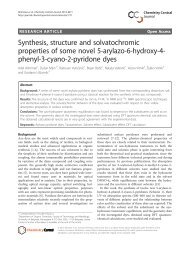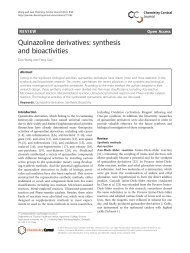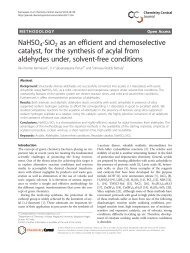Development and validation of stability indicating method for ...
Development and validation of stability indicating method for ...
Development and validation of stability indicating method for ...
Create successful ePaper yourself
Turn your PDF publications into a flip-book with our unique Google optimized e-Paper software.
Walash et al. Chemistry Central Journal 2011, 5:61<br />
http://journal.chemistrycentral.com/content/5/1/61<br />
Page 4 <strong>of</strong> 11<br />
Fluorescence Intensity<br />
160<br />
140<br />
120<br />
100<br />
80<br />
60<br />
40<br />
20<br />
a<br />
0<br />
250 300 350 400 450 500 550 600 650 700 750 800<br />
a) Excitation Spectrum <strong>of</strong> drug.<br />
b) Emission Spectrum <strong>of</strong> drug.<br />
a`) Excitation Spectrum <strong>of</strong> Blank.<br />
b`) Emission Spectrum <strong>of</strong> Blank.<br />
a`<br />
Wavelength (nm.)<br />
Figure 3 Fluorescence spectra <strong>of</strong> the reaction product. (A,B)<br />
SER ( 2.5 μg/mL) with 0.2% NBD-Cl at pH 7.8. (A’, B’) blank with<br />
0.2% NBD-Cl at pH 7.8.<br />
was obtained at pH 7.7 <strong>and</strong> remained constant up to 7.9<br />
after which the absorbance <strong>of</strong> the reaction product<br />
began to decrease gradually until pH 9. There<strong>for</strong>e, pH<br />
<strong>of</strong> 7.8 ± 0.1 was chosen as the optimum one (Figure 4).<br />
Other buffers having the same pH value such as phosphate<br />
<strong>and</strong> hexamine were tried <strong>and</strong> compared with<br />
0.2 M borate buffer. Borate buffer was found to be<br />
superior to other buffers having the same pH value since<br />
the net fluorescence intensity was highest in case <strong>of</strong><br />
borate buffer. This is probably, because the rate <strong>of</strong> hydrolysis<br />
<strong>of</strong> NBD-Cl to NBD-OH was much slower. This<br />
result is in agreement with that <strong>of</strong> Miyano et al [24].<br />
Effect <strong>of</strong> concentration <strong>of</strong> NBD-Cl<br />
The influence <strong>of</strong> the concentration <strong>of</strong> NBD-Cl was studied<br />
using different volumes <strong>of</strong> 0.2% w/v solution <strong>of</strong> the<br />
reagent. It was found that, the reaction <strong>of</strong> NBD-Cl with<br />
b<br />
b`<br />
SER started upon using 0.2 mL <strong>of</strong> the reagent in the<br />
presence <strong>of</strong> borate buffer (pH 7.8). Increasing the<br />
volume <strong>of</strong> the reagent, produces a proportional increase<br />
in the absorbance <strong>of</strong> the reaction product up to 0.8 mL<br />
<strong>and</strong> remains constant up to 1.2, after which further<br />
increase produces a gradual decrease in the absorbance<br />
value. There<strong>for</strong>e, 1 mL <strong>of</strong> 0.2% w/v <strong>of</strong> NBD-Cl solution was<br />
chosen as the optimal volume <strong>of</strong> the reagent (Figure 5).<br />
Effect <strong>of</strong> heating temperature<br />
Different temperature settings were used with constant<br />
heating time. Increasing the temperature <strong>of</strong> the water<br />
bath was found to produce a proportional increase in<br />
the absorbance <strong>of</strong> the reaction product up to 55°C <strong>and</strong><br />
remained constant until 65°C after which further<br />
increase in the temperature produces a gradual decrease<br />
in the absorbance value, so the optimum temperature<br />
<strong>for</strong> study was 60°C ± 5°C (Figure 6).<br />
Effect <strong>of</strong> time<br />
The time <strong>of</strong> heating is an essential part <strong>of</strong> the experiment.<br />
Different time intervals were tested to ascertain<br />
the time after which the solution attains its highest<br />
absorbance. It was found that after 25 min, the reaction<br />
product reaches the highest absorbance (Figure 7). It<br />
was observed that heating time <strong>for</strong> 25 min is adequate<br />
<strong>and</strong> the absorbance <strong>of</strong> the reaction product is stable <strong>for</strong><br />
about 40 min. at room temperature.<br />
The fluorescence intensity or absorbance value <strong>of</strong> the<br />
hydrolysis product <strong>of</strong> NBD-Cl, namely,4-hydroxy-7-<br />
nitrobenzo-2-oxa-1,3-diazole (NBD-OH) is quenched by<br />
decreasing the pH <strong>of</strong> the reaction medium to less than<br />
1. There<strong>for</strong>e, acidification <strong>of</strong> the reaction mixture prior<br />
to measurement <strong>of</strong> the fluorescence intensity or absorbance<br />
value remarkably decreased the background fluorescence<br />
or absorbance due to the <strong>for</strong>mation <strong>of</strong> NBD-<br />
OH without affecting the drug reagent adduct, hence<br />
the sensitivity was increased.<br />
Absorbane<br />
1.400<br />
1.200<br />
1.000<br />
0.800<br />
0.600<br />
0.400<br />
0.200<br />
0.000<br />
7.0 7.5 8.0 8.5 9.0 9.5<br />
pH<br />
Figure 4 Effect <strong>of</strong> pH <strong>of</strong> borate buffer 0.2 M on the<br />
absorbance <strong>of</strong> the reaction product <strong>of</strong> SER (20 μg/mL) with<br />
NBD-Cl.<br />
Absorbane<br />
1.400<br />
1.200<br />
1.000<br />
0.800<br />
0.600<br />
0.400<br />
0.200<br />
0.000<br />
0.0 0.5 1.0 1.5 2.0<br />
Volume <strong>of</strong> 0.2% NBD-Cl (ml)<br />
Figure 5 Effect <strong>of</strong> volume <strong>of</strong> NBD-Cl 0.2% (w/v) on the<br />
absorbance <strong>of</strong> the reaction product <strong>of</strong> SER (20 μg/mL) with<br />
NBD-Cl.





